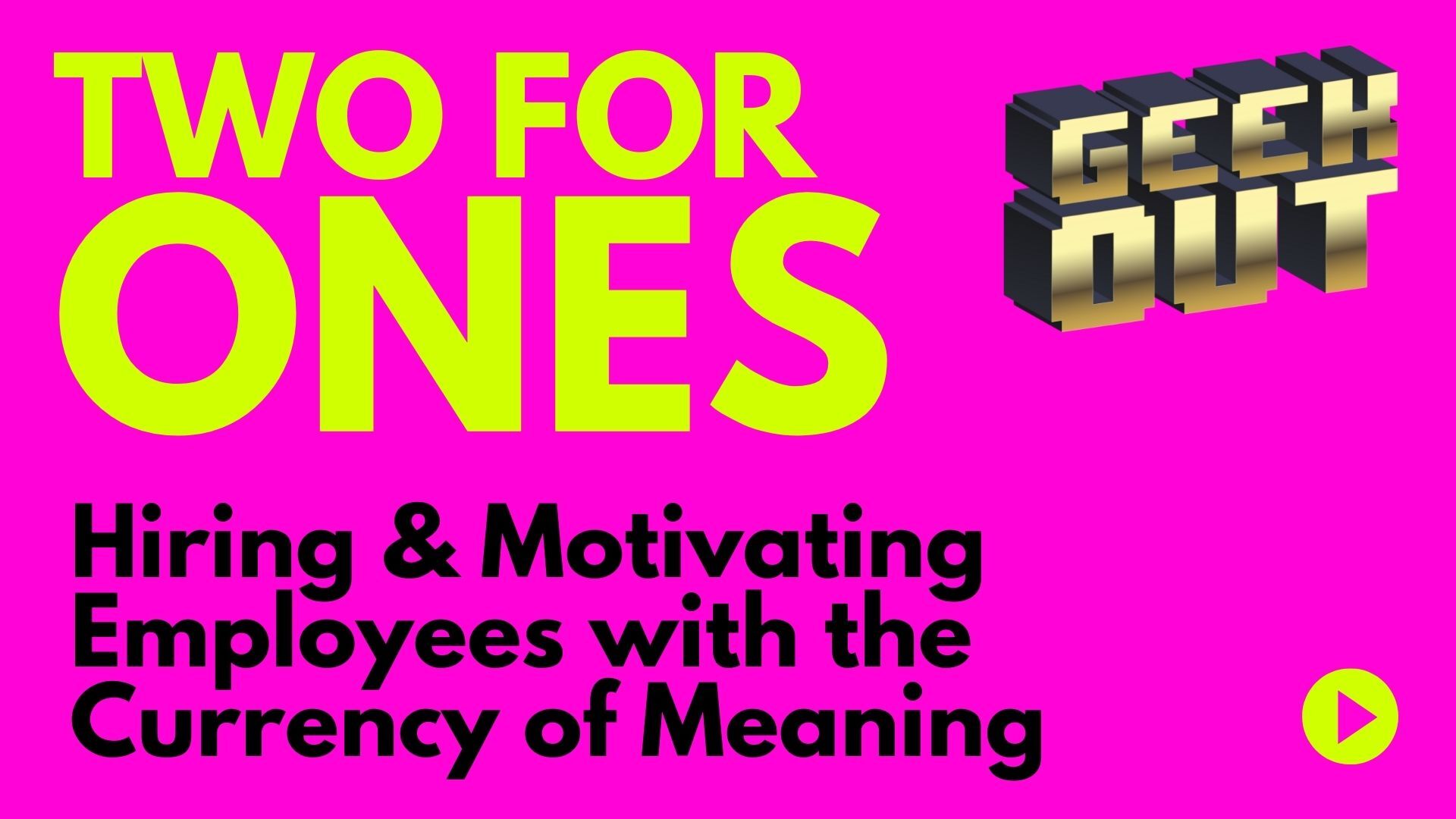
Two-For-Ones (Part Two): Hiring & Motivating Employees with the Currency of Meaning


Motivating with money alone is lazy, inefficient, and cheap. To truly unlock employees and get two-for-ones, we must find people’s correct currency of meaning.
There are examples of this all throughout history. For example, in times of war, countries would outsource operations to hired soldiers, who were called Hessians, to kill for them.
It might seem like a good idea, but who is more motivated to win in a life-and-death struggle — the people getting paid to be there, or the people who are trying to protect their families, their homes, and their livelihoods? The people who are more committed are more likely to win, which is why it’s important to find a currency that’s more important than money.
Sex is another example. You can fall in love with someone and have a deep, meaningful relationship that includes sex, or you can *ahem* pay someone for that same physical experience without the relationship or intimacy behind it.
That principle also applies to the working world. You can pay anyone to be an employee. But if you find someone who believes in your company and wants to invest in shared growth, that person will have a greater and more positive impact on your success.
3 Examples of Currency of Meaning
Motivating people with something meaningful is more important than ever. In today’s society, basic survival needs are more or less guaranteed. When survival is assured, we as employers (and as people) need to find and provide meaning.
1. Empowering Selfless Self-Improvement
One way to provide meaning — while still making money, of course — is by empowering selfless self-improvement.
Helping people get better at their job will help them be better employees for you. When you help people grow and improve their skill sets, they will appreciate you and work harder for you because they feel appreciated. They’ll feel valued and hold on to that feeling even if they move on to another position.
2. The 90/110 Rule
Another alternate currency is what we call the 90/110 rule. We want our employees to be “90% busy, and 110% challenged.”
If your teams are 100% busy all the time, that’s not a stable working environment because your people will get burned out. You should want your employees to have enough time to improve themselves. You want them to have enough time to think about the job they’re doing to make sure they do it well.
And when we say “110% challenged,” that’s not defined by the hours people work, but by what you ask them to do. You want to find tasks and goals for your employees that force them to stretch their role, get outside of their comfort zone, learn something new and improve at it.
3. No-Contact Vacations
The last thing is vacations. We’ve always forced, and enforced, no-contact-with-the-company vacations. And there’s another two-for-one here. First, requiring vacations shows that we value the employee’s time, and that we want them to reload and enjoy the time off.
The second thing is that when people go away on vacation, you get a clear picture of any problems or issues that get swept under the rug when they’re in their seats.
Labor optimization is also a responsibility. We have to pay our teams back for what they do for us. As an employer, that requires vigilance in a number of ways. To set your teams up for the utmost success, you have to:
- Bring in equal-caliber teammates for your best people
- Remove subpar teammates who don’t pull their weight
- Challenge and unlock people’s potential
- Find and provide value in their preferred currency of choice
- Respect and value their time
Today, two of the keys to effective labor management are hiring and indoctrination.
Hiring Concepts
First, interviewing and hiring potential employees is an extremely valuable exercise for current employees. The initial benefit is obvious — you’re bringing in someone new. But if you can turn it into a management and motivation tool, that’s also very powerful.
1. The “Free Raise” of Interviewing
When you need someone new, usually HR or an agency does the first interview, then a manager does an interview, and the person at the top says yes or no to that new hire. That’s the typical path.
I found out, however, that until Apple reached 70 employees, Steve Jobs would have every employee interview a candidate to see if the latter was a good culture fit.
When I started doing this, I realized that these interviews were an awesome opportunity to motivate our existing teams. Asking employees to do cross-department interviews, for example, shows that you’d like that employee to become a manager and learn that skillset as a part of their growth.
Also, asking someone else to do interviews shows that they’re as much of a defining part of the company and culture as the owner or someone else on the C-level.
In other words, this is the employee’s business too, and new hires should be a good fit with your best players, not just management. If you can use that motivation as a currency, it’s basically a “free raise” that can lead to more money and opportunities in the future.
How to Make Interviews Free Raises
To make interviews into free raises, you’ll need to:
- Have a conversation with the interviewer-to-be about why you’re doing this
- Give them scorecards with your questions and help them add their own
- Review the score and their analysis to see what they think of the way you think
- See how they think
- Make managers take responsibility for their decisions — if you chose to hire someone, you have to fire them too
The standard scorecard questions we use are:
- Do they take pride in their work?
- Do they seem like a good-hearted person?
- Will they work till it’s done?
- Do they seem like a hard worker?
- Do they seem like a team player?
- Will clean up after themselves in the shared kitchen?
- Are they competitive?
That last question is very important. We’ve found that one of the best attributes of our best employees is that they’re competitive.
Mark Ford, the founder of Agora, told me that “if you want to make $100 million, hire smart people. If you want to make $1 billion, hire competitive people.” That company grew when the owners split the company up into pieces and let their top employees compete with each other.
Today, if you go into Agora’s offices, you’ll see each team’s score from the day before posted on their door, along with rankings that show what everyone else is doing. Competitiveness takes things to another level.
2. Seat Pressure
Seat pressure is important in any business. Employees know that their job is safe if you never hire new people.
Also, diamonds shine brighter when you’re searching for other diamonds. In other words, everyone is on their best behavior at work for the first six months, but they lose that drive without additional and external motivators like seat pressure.
3. Read People, Not Resumes
If you’re trying to hire someone that you expect to stay on for years, the psychological and cultural fit is more important than the baseline skills or education on their resume.
If there is some technical knowledge required you can make sure that they have it, but at the interview stage you should be more focused on the personal side of the equation.
4. Interview the Interviewer
If you have an employee interview a potential new hire, it’s essential to follow up by interviewing the interviewer. Find out what their impressions were. Listen to their opinions and ask thoughtful questions.
Not only will you get a better understanding of the candidate, but you’re reinforcing that you care about your current employee’s insights.
Interview Questions
These are some additional questions we like to use to find out about the person, not the paper. The answers will give you a good sense of whether or not a person is right for the role.
- Who was your favorite boss and why?
- Who was your least favorite boss and why?
- If I had to pay you without money what would you want?
- What will come after this job?
- What time do you sleep and when do you wake up?
- Do you have siblings and what do they do?
- Where are you in the birth order?
- What do/did your parents do?
Indoctrination
Lots of companies focus on indoctrinating their clients and using brand messaging, but one of the most overlooked opportunities for business owners is indoctrinating their employees. This is a problem that I see constantly.
1. History
Believe it or not, a good example of successful indoctrination comes from prisons. Life in prison is a fascinating thing because there are no laws or traditions to hold onto, and every decision has life-and-death consequences.
The top two gangs in prisons are the Aryan Brotherhood and the Mexican Mafia. You would think that joining a prison gang for survival and protection would be enough of a motivator, but it’s not. There’s a multi-year process of learning and mentorship, even in prison gangs!
Both of these gangs make their new members learn the ancient language of their “race originators” — Norse and Aztec, respectively — so that they can take pride in their heritage. They understand indoctrination, but companies today do not.
Step one of effective indoctrination, then, is history. When you hire someone, have a veteran employee or a founder sit them down and explain the history of your company. Who are you? Why did you start the company? What did the founders do before this business? Where are you going to work?
When you communicate with your new employees, think about what they’ll tell their significant others when they go home after that first day. If you can get them to internalize the story of your company and understand what they’re a part of now, you’re on the right track. This way employees know who they’re working for and what they’re working toward.
2. Mentorship
The second step is mentorship. Media buying is very experience- and skill-based. You can’t go to school to learn how to buy YouTube Ads effectively — there’s a craftsmanship to it. And mentorship is the key way to pass on those skills and lessons to new generations of media buyers.
Mentorship also creates cohesion within your team. You’re creating an environment where sharing knowledge is more than encouraged — it’s required.
3. Cross-Department Education
Cross-department education is more valuable than you might think. All it takes is one hour per week. Have someone from one department show a person in a different department how they do their job.
The benefits of this practice are astronomical. Do you want your copywriters to level up? Teach them how to do media buying. Do you want better media buyers? Teach them how to write copy.
Two things will happen. One, the learners will get better at their jobs, and two, the teachers will feel more engaged with their work because they have a better view of what the larger team is doing. Also, both parties will feel less confined to their particular ‘silo’ and will be more open to cross-department collaboration.
Click here for Part One of this post, and stay tuned for Part Three, Individual Optimization Methods, coming soon!
For more marketing and leadership lessons from industry experts and entrepreneurs, check out James' P3 Scaling System to grow your business, or click here to sign up for the next Geek Out event!



